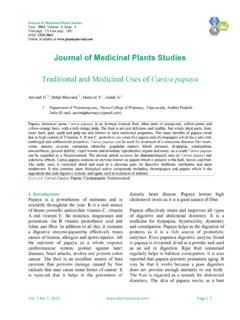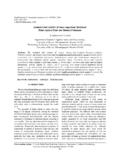Transcription of ANTIBACTERIAL ACTIVITY OF PLANT EXTRACTS …
1 Brazilian Journal of Microbiology (2000) 31:247-256 ANTIBACTERIAL ACTIVITY of PLANT EXTRACTS ISSN 1517-8382. ANTIBACTERIAL ACTIVITY OF PLANT EXTRACTS AND PHYTOCHEMICALS ON ANTIBIOTIC- RESISTANT BACTERIA. Gislene G. F. Nascimento1*; Juliana Locatelli1; Paulo C. Freitas1,2; Giuliana L. Silva1. 1. Faculdade de Ci ncias da Sa de, Universidade Metodista de Piracicaba, Piracicaba, SP, Brasil. 2. Faculdade de Ci ncias Farmac uticas, Universidade de S o Paulo, S o Paulo, SP, Brasil Submitted: October 21,1999; Approved: November 14, 2000. ABSTRACT. The antimicrobial ACTIVITY of PLANT EXTRACTS and phytochemicals was evaluated with antibiotic susceptible and resistant microorganisms.
2 In addition, the possible synergistic effects when associated with antibiotics were studied. EXTRACTS from the following plants were utilized: Achillea millifolium (yarrow), Caryophyllus aromaticus (clove), Melissa offficinalis (lemon-balm), Ocimun basilucum (basil), Psidium guajava (guava), Punica granatum (pomegranate), Rosmarinus officinalis (rosemary), Salvia officinalis (sage), Syzygyum joabolanum (jambolan) and Thymus vulgaris (thyme). The phytochemicals benzoic acid, cinnamic acid, eugenol and farnesol were also utilized. The highest antimicrobial potentials were observed for the EXTRACTS of Caryophyllus aromaticus and Syzygyum joabolanum, which inhibited and of the tested microorganisms, respectively, with higher ACTIVITY against antibiotic-resistant bacteria ( ).
3 Sage and yarrow EXTRACTS did not present any antimicrobial ACTIVITY . Association of antibiotics and PLANT EXTRACTS showed synergistic ANTIBACTERIAL ACTIVITY against antibiotic-resistant bacteria. The results obtained with Pseudomonas aeruginosa was particularly interesting, since it was inhibited by clove, jambolan, pomegranate and thyme EXTRACTS . This inhibition was observed with the individual EXTRACTS and when they were used in lower concentrations with ineffective antibiotics. Key words: PLANT EXTRACTS ACTIVITY ; medicinal plants ; antimicrobial ACTIVITY INTRODUCTION The problem of microbial resistance is growing and the outlook for the use of antimicrobial drugs in the future is still Even though pharmacological industries have produced a uncertain.
4 Therefore, actions must be taken to reduce this number of new antibiotics in the last three decades, resistance problem, for example, to control the use of antibiotic, develop to these drugs by microorganisms has increased. In general, research to better understand the genetic mechanisms of bacteria have the genetic ability to transmit and acquire resistance, and to continue studies to develop new drugs, either resistance to drugs, which are utilized as therapeutic agents (12). synthetic or natural. The ultimate goal is to offer appropriate Such a fact is cause for concern, because of the number of and efficient antimicrobial drugs to the patient.
5 Patients in hospitals who have suppressed immunity, and due to For a long period of time, plants have been a valuable source new bacterial strains, which are multi-resistant. Consequently, of natural products for maintaining human health, especially in new infections can occur in hospitals resulting in high mortality. the last decade, with more intensive studies for natural therapies. From 1980 to 1990, Montelli and Levy (27) documented a The use of PLANT compounds for pharmaceutical purposes has high incidence of resistant microorganisms in clinical gradually increased in Brazil.
6 According to World Health microbiology in Brazil. This fact has also been verified in other Organization (31) medicinal plants would be the best source to clinics around all over world. obtain a variety of drugs. About 80% of individuals from * Corresponding author. Mailing address: Faculdade de Ci ncias da Sa de, Universidade Metodista de Piracicaba, Caixa Postal 68, CEP 13400-911, Piracicaba, SP. Fax: (+5519) 433-2909. E-mail: 247. Nascimento et al. developed countries use traditional medicine, which has yeast, and showed it had ACTIVITY against Bacillus cereus, E.
7 Coli, compounds derived from medicinal plants . Therefore, such P. aeruginosa, S. aureus and S. epidermidis (13). plants should be investigated to better understand their Effects of phytochemical were conducted (19, 20) and it properties, safety and efficiency (14). was observed the antimicrobial ACTIVITY of anacardic acid on S. The use of PLANT EXTRACTS and phytochemicals, both with aureus, Brevibacterium ammoniagenes, Streptococcus known antimicrobial properties, can be of great significance in mutans and Propionibacterium acnes. Later, it was tested the therapeutic treatments.
8 In the last few years, a number of studies bactericidal ACTIVITY of anacardic acid and totarol on methicillin have been conducted in different countries to prove such resistant strains of S. aureus (MRSA) and the synergistic effect efficiency (1,5,18,19,22,35,36). Many plants have been used of these compounds associated with methicillin (28). because of their antimicrobial traits, which are due to Hence, more studies pertaining to the use of plants as compounds synthesized in the secondary metabolism of the therapeutic agents should be emphasized, especially those PLANT .
9 These products are known by their active substances, for related to the control of antibiotic resistant microbes. The example, the phenolic compounds which are part of the essential objective of this research was to evaluate the potential of PLANT oils (20), as well as in tannin (33). EXTRACTS and phytochemicals on standard microorganism strains The antimicrobial properties of plants have been investigated as well as multi-drug resistant bacteria, which were isolated by a number of researchers world wide, especially in Latin from hospitals. Moreover, we investigated the synergistic America.
10 In Argentina, a research tested 122 known PLANT effects of EXTRACTS with antimicrobial ACTIVITY in association species used for therapeutic treatments (4). It was documented with antibiotics against drugs resistant bacteria. that among the compounds extracted from these plants , twelve inhibited the growth of Staphylococus aureus, ten inhibited MATERIALS AND METHODS. Escherichia coli, and four inhibited Aspergillus niger and also reported that the most potent compound was one extracted from Microbial samples Tabebuia impetiginosa. The antimicrobial properties of Fourteen microbial species were analyzed.















